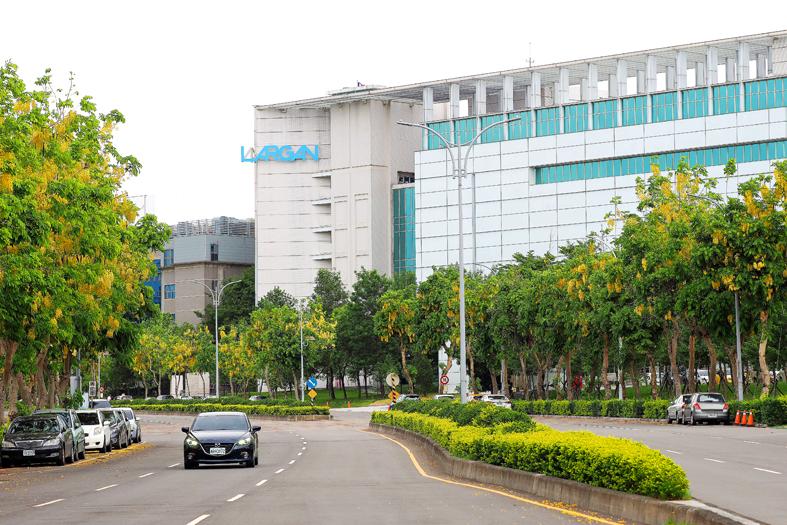Largan Precision Co’s (大立光) gross margin improved in the second quarter of this year thanks to foreign exchange gains and production cost-intensive voice coil motors (VCMs) accounting for a lower share of sales, the smartphone camera lens maker reported yesterday.
Gross margin rose to 55.8 percent, up 2.44 percentage points from 53.36 percent in the first quarter and ending four consecutive quarters of declines, said the leading maker of optical lens modules, which also produces VCMs and sleep monitoring systems.
In the second quarter of last year, gross margin was 60.29 percent, company data showed.

Photo: David Chang, EPA-EFE
Largan did not provide a guidance for gross margin in the second half of the year, as the measure of profitability is subject to multiple factors, including the scale of production, product yield rate, product mix, capacity utilization rate and foreign exchange rate, Largan chief executive officer Adam Lin (林恩平) told an online investors’ conference.
The Taichung-based firm’s net profit was NT$4.95 billion (US$165.6 million) last quarter, down 10.29 percent from a quarter earlier. On a year-on-year basis, profit was up 67.12 percent.
Nonoperating gains contributed NT$2.17 billion, including foreign exchange gains of NT$1.79 billion, Largan said.
As a result, earnings per share were NT$37.06 last quarter, compared with NT$41.3 in the previous quarter and NT$22.7 a year earlier, the company said.
Revenue declined to NT$9.68 billion in the second quarter, down 4.51 percent quarterly and 4.33 percent annually, Largan said, attributing the trend to the COVID-19 lockdowns in China, supply chain snags and consumer market weakness.
Last quarter’s revenue was the lowest since the first quarter of 2018, when sales were NT$8.88 billion, company data showed.
As customers are preparing to launch new smartphones in the fall, the company’s revenue for this month would be higher than last month’s, Lin said, adding that the trend would continue next month.
Largan faces low competition in the high-end mobile phone lens market, and it is to ship 7P and 8P lens modules in the second half of this year, Lin said.
A 7P lens contains seven layers and is more advanced than lenses with fewer layers.
However, demand for such high-end lenses remains weak, as customers are generally less upbeat about the end market amid slowing phone sales worldwide, he said.
Higher inventories could pose another issue for supply chains, he added.
As for the construction of new manufacturing facilities in Taichung, Lin said the new plant is facing a labor shortage.
Therefore it would not start production in the middle of next year as scheduled, he said, adding that the plant would likely provide revenue contribution as early as the fourth quarter of next year.
In the first half of this year, Largan’s revenue totaled NT$19.81 billion, down 10 percent from NT$21.93 billion a year earlier.
It reported net profit of NT$10.46 billion, up 26 percent year-on-year, or earnings per share of NT$78.36, and gross margin of 54.55 percent.

TRADE WAR: Tariffs should also apply to any goods that pass through the new Beijing-funded port in Chancay, Peru, an adviser to US president-elect Donald Trump said A veteran adviser to US president-elect Donald Trump is proposing that the 60 percent tariffs that Trump vowed to impose on Chinese goods also apply to goods from any country that pass through a new port that Beijing has built in Peru. The duties should apply to goods from China or countries in South America that pass through the new deep-water port Chancay, a town 60km north of Lima, said Mauricio Claver-Carone, an adviser to the Trump transition team who served as senior director for the western hemisphere on the White House National Security Council in his first administration. “Any product going

STRUGGLING BUSINESS: South Korea’s biggest company and semiconductor manufacturer’s buyback fuels concerns that it could be missing out on the AI boom Samsung Electronics Co plans to buy back about 10 trillion won (US$7.2 billion) of its own stock over the next year, putting in motion one of the larger shareholder return programs in its history. South Korea’s biggest company would repurchase the stock in stages over the coming 12 months, it said in a regulatory filing on Friday. As a first step, it would buy back about 3 trillion won of paper starting today up until February next year, all of which it would cancel. The board would deliberate on how best to effect the remaining 7 trillion won of buybacks. The move

China’s Huawei Technologies Co (華為) plans to start mass-producing its most advanced artificial intelligence (AI) chip in the first quarter of next year, even as it struggles to make enough chips due to US restrictions, two people familiar with the matter said. The telecoms conglomerate has sent samples of the Ascend 910C — its newest chip, meant to rival those made by US chipmaker Nvidia Corp — to some technology firms and started taking orders, the sources told Reuters. The 910C is being made by top Chinese contract chipmaker Semiconductor Manufacturing International Corp (SMIC, 中芯) on its N+2 process, but a lack

NVIDIA PLATFORM: Hon Hai’s Mexican facility is to begin production early next year and a Taiwan site is to enter production next month, Nvidia wrote on its blog Hon Hai Precision Industry Co (鴻海精密), the world’s biggest electronics manufacturer, yesterday said it is expanding production capacity of artificial intelligence (AI) servers based on Nvidia Corp’s Blackwell chips in Taiwan, the US and Mexico to cope with rising demand. Hon Hai’s new AI-enabled factories are to use Nvidia’s Omnivores platform to create 3D digital twins to plan and simulate automated production lines at a factory in Hsinchu, the company said in a statement. Nvidia’s Omnivores platform is for developing industrial AI simulation applications and helps bring facilities online faster. Hon Hai’s Mexican facility is to begin production early next year and the